Chord Extensions
After practicing and building basic chords, the next step is to practice more complex chords with Chord Extensions. These chord
extensions add to the base major, minor, augmented, and diminished chord triads. Chord extensions are great substitutes to add more
variety and interest instead of playing a simple chord progression. The most
common include sixths, sevenths, ninths, elevenths, and thirteenths.
The first example will demonstrate three methods to build a C major seventh chord. To build this chord from a scale, use the notes from
a C major scale (C, D, E, F, G, A, B). The major seventh’s chord formula is 1, 3, 5, 7. These step numbers indicate which notes to pull
from the C major scale. So, the notes in a C major seventh chord are C, E, G, and B, the first, third, fifth, and seventh note. The
second method is to build this C major seventh chord from intervals instead of a scale. Start with a major third interval from the root
note C to get the E note. From E, use a minor third interval to get the G note. To get the B note from G, another major third interval
is required. The third method is to use all intervals from the root note C, which would be a major third, perfect fifth, and major
seventh. Figure 1 shows the C major seventh chord.
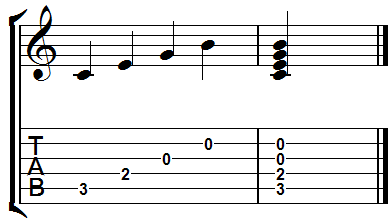
Figure 1 -
C Major Seventh Notes and Chord
In this second example, an A minor seventh chord, use the notes from an A minor scale (A, B, C, D, E, F, G). The chord’s formula
is 1-b3-5-b7. Take the first, third, fifth, and seventh notes from the A minor scale. This will give the notes A, C, E, and G. Remember,
the formula is based on the major scale. The minor scale already has the third and seventh steps flatted, which makes the Am7 chord easier
to build with a minor scale. To build this chord from an A major scale (A, B, C#, D, E, F, G#), take the first, flat third, fifth, and
flat seventh notes. To build this Am7 chord using intervals instead of a scale, begin with a minor third interval from the root note
A. This will get the second note C. From C, move a major third interval to get the E note. The fourth note G comes from a minor third
interval from E. To use only intervals from the root note A, use a minor third, major fifth, and minor seventh interval. Figure
2
shows the Am7 chord.
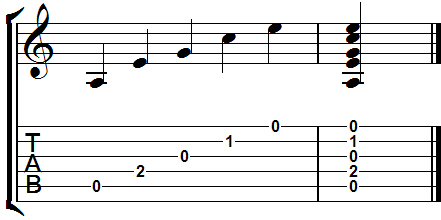
Figure 2 -
A Minor Seven Notes and Chord
Now it is more clear from these examples that they use base major and minor triads and add on a fourth note to create the seventh
chords. Triad chords can be extended with many different note combinations to produce countless possibilities! This process works
great when a basic chord needs to be substituted with a more colorful chord. To become a better musician, practice applying many
different extensions to base chords to produce creative and unique chords.
Chord Voicings
Chord Voicings are simply the note order chords are played with. Changing the order which a chord is played slightly changes how that
chord type will sound. Every chord can be played with different chord voicings. This is very important for songwriters to find the
right chord voicing for the chord progression they are composing. For example, the C major ninth chord (Cmaj9) has the formula
is 1, 3, 5, 7, 9, and the notes in this chord are C, E, G, B, and D. This chord is the same as the C major seven chord, but extended
to add the ninth step. Figure 3 below shows one Cmaj9 chord voicing.
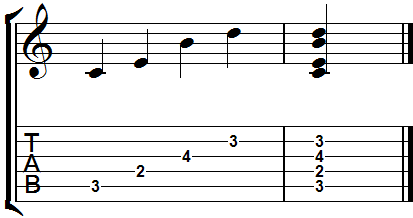
Figure 3 -
C Major Ninth Chord Voicing
There are many possible note order combinations to study and practice. For example, a C major chord has 3 notes (C, E, G). How many
notes will be played? Three notes (C, E, G)? Four Notes (C, E, G, C)? Five notes (C, E, G, C, E)? However, be careful which note is
removed, like in the C major ninth example from Figure 3. Notice in this chord voicing, the fifth step G note has been removed. Certain
step numbers may be very important voice leading notes in the song’s harmony. Some notes provide the chord with its unique quality,
tension, or release (3rd and 7th steps). Also, a note is sometimes omitted if another instrument is playing that note.
Chord voicing allows a great deal of freedom and creativity building chords and chord progressions. Remember, the note order from the
chord’s formula is not the only order a chord has to be played with. Students should practice building chords with various chord voicings
with a strong focus on listening to the sound each chord voicing produces.
Chord Inversions
Chord Inversion is playing a chord but arranging the notes in a different order than the chord’s
formula. The number of inversions that can be done to any particular chord depends on how many notes are in the chord. The rule is
apply one less inversion than the total number of notes in a chord. So, C major chord (C, E, G) has three notes and therefore, two
inversions. To invert the notes of this chord, simply rearrange the note order. C major first inversion would begin with the second
note E, producing the note order E, G, C. C major second inversion would begin with the third note G, producing the note
order G, C, E. These note order changes do create chord voicings, which makes chord inversions very similar to chord voicings. Please
note that a chord inversion rearranges the chord’s note order, while a chord voicing may change how many notes are used or even remove a
note when played (see Figure 3 - C major ninth chord). Students should practice chord inversions each time a chord is constructed. If
a chord progression does not sound quite right for the song, try a different chord inversion or voicing before substituting a whole
new chord. Figure 4 below shows the inversions for the C major chord.
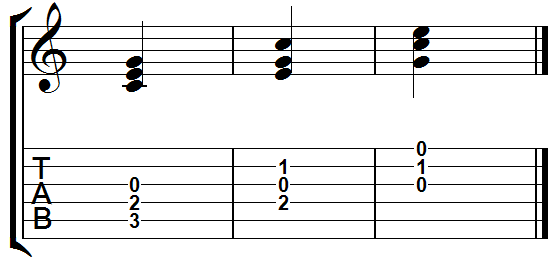
Figure 4 -
C Major Chord, first inversion and second inversion
Diminished seventh chords have an interesting chord inversion. Four diminished seventh chords all use the same four notes. So, each
inversion is another chord! For example, Cdim7 has the notes C Eb, Gb, and Bb. Ebdim7 has the notes Eb, Gb, Bb, and C. Notice how the
Ebdim7 chord is the same as a Cdim7 first inversion. This is true for other chords too, like major sixth and minor seventh chords. A
Cmaj6 chord has the notes C, E, G, and A. The Amin7 chord has the notes A, C, E, and G. The Amin7 chord is the same as a third inversion
Cmaj6 chord. Table 1 below shows a few examples of chords that share the same notes.
Chord type |
Chord type with the same notes |
Diminished Seventh
Cdim7 (C, Eb, Gb, A)
Ddim7 (D, F, Ab, B)
Edim7 (E, Gb, Bb, Db)
|
Inverted Diminished Seventh
Ebdim7, Gbdim7, Adim7
Fdim7, Abdim7, Bdim7
Gdim7, Bbdim7, Dbdim7
|
Suspended Second (ISus2)
CSus2 (C, D, G)
|
Suspended Fourth (VSus4)
GSus4 (G, C, D)
|
Suspended Fourth (ISus4)
CSus4 (C, F, G)
|
Suspended Second (IVSus2)
FSus2 (F, G, C)
|
Major Sixth (Imaj6)
Cmaj6 (C, E, G, A)
|
Minor Seventh (vim7)
Am7 (A, C, E, G)
|
Major Seventh (Imaj7)
Cmaj7 (C, E, G, B)
|
Minor Flat Sixth (iiimb6)
Emb6 (E, G, B, C)
|
Major Seven, Sharp Eleven (Imaj#11)
Cmaj7#11 (C, E, G, B, F#)
|
Minor Flat Six, Nine (iiimb6/9)
Emb6/9 (E, G, B, C, F#)
|
Table 1 - Chord types with the same notes
Poly Chords
Poly Chords, sometimes called stacked or compound chords, are two chords combined together to make one
large chord. Poly chords are much easier to understand after walking through an example. The first example is the C major seven
chord (Cmaj7). The notes in this chord are C, E, G, and B. This chord is build from combining the notes of a C major chord with an
E minor chord. The C major chord has the notes C, E, G, and the E minor chord has the notes E, G, and B. Notice the E and G notes
used in both chords. Why are these two particular chords combined? To build a major seven chord quickly, simply combine the major
scale’s first step chord with the third step chord. In the C major scale, Cmaj is the first step chord and Em is the third step
chord. Here is another example with the G major scale. To build a Gmaj7 chord (G, B, D, F#), simply combine a Gmaj chord (G, B, D)
with a Bm chord (B, D, F#). Notice the B and D notes are common in both chords. Poly chords are used in many instances when chord
substitution is required to improve simple chord progressions. Figure 5 below shows the Cmaj7 chord example.
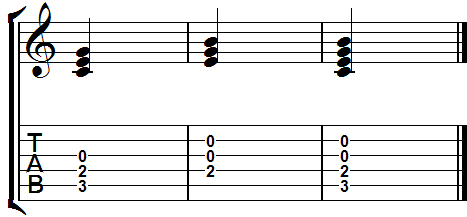
Figure 5 -
Combining C Major and E Minor chords to build a C Major Seven
Slash Chords
Slash Chordshave a different bass note than the chord’s root note, and non slash chords use the root
note as its bass note. The bass note is the lowest note in the chord. For example, the C major chord (C, E, G) has the C note for
its bass note. The root note is the first step note and is also the same note in the name of the chord. To make this chord a slash
chord, indicate the new bass note with a diagonal slash in the chord name, like Cmaj/G. In the Cmaj/G example, the chord is still a
C major chord, but uses the G note as the new bass note. Any note can be used as the new bass note. It does not have to be a note in
the chord. Another example is Gmaj/F#. The G chord (G, B, D) is adding a new bass note (F#) to the chord. Figure 6 below
demonstrates the Cmaj/G chord. Note that the lowest note is the G note.

Figure 6 -
Cmaj/G Chord